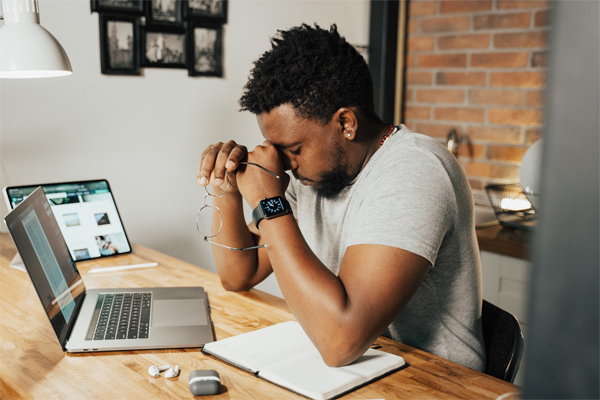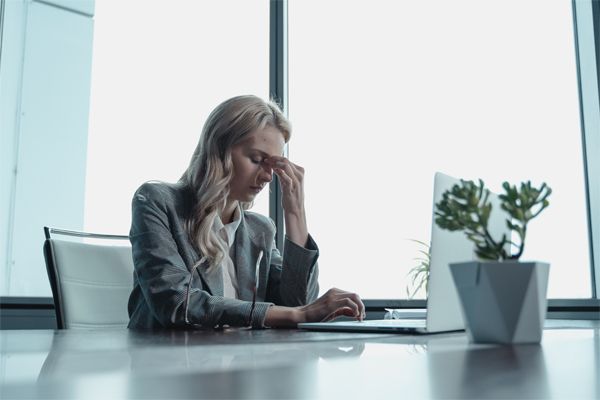New research has revealed that some occupational health issues have increased more than three-fold this year alone, as the majority of staff continue to work from home amid the pandemic.
The report found a dramatic rise in UK searches for terms like ‘sore eyes’, ‘sick building syndrome’, ‘back pain’ and ‘occupational burnout’, in the first two months of 2021; compared to the same period in 2020. Searches for ‘digital eye strain’ soared by 450%; followed by 170% increase for sore eyes and 111% for eye strain relief. Searches for ‘blue light glasses’ also increased by 314% year on year compared to before the lockdown.
The use of sub-par display equipment, small laptop screens, or additional time spent at screens has led to employees taking matters into their own hands for harm reduction, according to the research. The findings come from online research analysis, along with insights from a health study, carried out by Vape Club.

Image credit: Tima Miroshnichenko, Pexels
RISING WORK STRESS & BURNOUT
Work-related stress and burnout also continues to rise. Online searches for symptoms with terms such as ‘signs of burnout’ increased by 24% throughout 2020, compared to the previous year. However, global online searches for the term ‘occupational burnout’ have increased by more than 2,500% since 2015; and the Covid-19 pandemic has fuelled an even faster rise in work-related mental health issues.
There has also been a 137% increase in searches for sick building syndrome, symptoms caused by unsuitable working environments involving:
- Poor ventilation or poorly maintained air conditioning systems.
- Dust, smoke, fumes or fabric fibres in the air.
- Bright or flickering lights.
- Problems with cleaning and layout, such as crowded desks.
These conditions can cause symptoms such as headaches, itchy skin, sore eyes or throat, coughing, rashes, or tiredness and difficulty concentrating. Although it’s difficult to pinpoint the root cause of these symptoms, there are aspects of home living spaces that ‘could be the’culprit’, pointed out the research.
WORK-RELATED HEALTH COMPLAINTS
Online searches in the UK suggest that there has been a 10% rise in employees suffering from complaints linked to musculoskeletal conditions. These are common issues for office desk workers that spend a lot of time sitting; and can be worse for home-workers who have no commute to get them moving everyday.
- Back pain: 9% increase
- Neck pain: 5% increase
- Shoulder pain: 16% increase
- Shoulder blade pain: 27% increase
As well as the increase in occupational hazards for staff working from home, there has been a lack of clarity from companies on sick-leave policy that has led to mass presenteeism, and employees working whilst unwell. In fact, searches for ‘sick day rules’ more than doubled over the last year, revealed the analysis.

Image credit: Yan Krukov, Pexels
ILL-HEALTH & WORKPLACE PRESENTEEISM
Another study conducted in 2020 by Vitality, confirmed that the UK economy lost almost £92 billion in 2019 as a result of ill-health related absence and presenteeism in the workplace. With World Health Day coming up on 7th April, it’s vital that employers must address staff health needs to keep wellbeing levels high and extra costs low. Given that home-working will continue to be a prominent part of working life post-lockdown, it is more crucial than ever that employers provide staff with adequate wellbeing packages; and ensure sick leave policies are clear and adequately adapted for the new norm.
Employers also have a responsibility to keep an eye on staff health and wellbeing. “If employers have systems in place that are designed for regular monitoring of each employee then problems can be identified and dealt with before they escalate,” pointed out Angela Knox, Director of workplace employee wellbeing programme Keep Fit Eat Fit. “Opportunities to intervene can easily be missed. In larger companies with higher head counts it is a good idea for the head of HR to have eyes and ears in the various departments so that they can keep track of any key developments or problems before they occur.”
WORKPLACE WELLBEING RECOMMENDATIONS
“Providing targeted and intelligent wellbeing services to employees is absolutely a remedy to this problem and medium to large businesses are certainly offering at least some wellbeing services to their employees,” added Lou Campbell, Co-founder and Programmes Director at Mindfulness in the Workplace. “A two-pronged approach works best; offering confidential one-to-one sessions to those who are in crisis or experiencing moderate to severe mental health issues; and awareness sessions focusing on how to maintain positive mental health, work life balance, healthy habits, whole-person health to the wider group of employees.”

Here are a few recommendations on how HR/managers/leaders can better tackle employee health issues:
Clear communication of sick leave
Communication hugely contributes to preventing those initial feelings of pressure that can stop employees feeling like they can take the sick leave they have been allocated. It’s vital to openly encourage employees to use sick leave regularly throughout the year, for a healthier work-life balance. This way you can potentially dilute occupational health issuesbefore they start to impact employees’ productivity and the business as a whole.
Supply of proper desk setup
Ensuring employees have the correct equipment and a suitable setup for home-working is crucial for preventing injuries that could affect overall productivity and wellbeing. It is essential that employees have an appropriate set up for maintaining their physical health.
This should include a back-supporting desk chair, screens at the correct height to eye level and display equipment or harm-prevention measures to reduce eye strain. The desirable work surface height should mean when sat up straight, forearms are parallel to the ground and wrists do not bend up or down when typing, which can cause musculoskeletal issues.
Encourage healthy lifestyles
Around 7.83% of the cost of lost business productivity is attributed to smoking-related absences and presenteeism. Recent research from Vape Club into smoking cessation in England found that in 2020 smoking cost companies £7.2 billion in lost productivity. Data analysis showed that smoking will cost businesses an additional £88.9 billion in lost productivity costs until the nation becomes officially ‘smoke-free’. Company policies should therefore encourage employees to keep up a healthy lifestyle; keep presenteeism at bay; and also save on costs in the long-term. These could include smoking cessation support, healthy lifestyle incentives, and encouraging fitness through paid-for classes; or even short brisk walks throughout the day.








































